
Quick Tips
- Clean your wooden cutting board with a dish detergent like Ivory Pure.
- Once a week, sanitize your wooden cutting board with a solution of one part white vinegar to five parts water.
- If you are worried vinegar and water isn't strong enough to kill the germs living on your wooden cutting board, switch to hydrogen peroxide
- For day-to-day cleaning of your wooden cutting board
- Once a month, resurface your wooden cutting board to prevent bacteria buildup.
- If once-a-week sterilizing and once-a-month refinishing isn't enough to rescue your cracked, warped, pocked chopping board
Your first defense against bacteria ninjas is having the right kind of cutting board. When choosing a wooden cutting board, also known as a butcher block, select tight-grain woods like basswood, beech, birch, maple, aromatic cedar, or mahogany, rather than oak or pine; the “pores” in these open-grain woods make a nesting place for bacteria. Also, choose cutting boards made from several panels rather than a single piece; these will warp less when exposed to water.
Check to make sure your cutting board was sourced from sustainable lumber supplies and harvested in an environmentally-friendly fashion. Look for the Forest Stewardship Council, or FSC, label. And read the manufacturer’s label carefully to ensure the glues utilized are approved by the FDA for use on kitchen equipment coming in direct contact with food. A good example of an FDA-approved glue is Titebond II, or its even more perfect younger sibling, Titebond III (nah, nah, nah nah nah!).
Arm Yourself for Wooden Cutting Board Cleaning
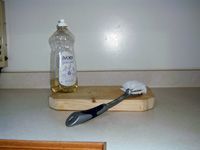 Clean your wooden cutting board with a dish detergent like Ivory Pure. Never use a laundry detergent or a harsh cleanser like PineSol or 409, as these will raise the grain and ruin the wood (not to mention the flavor of your food). Use a natural or nylon bristle scrub brush to remove invisible food particles, especially if the board has been used to cut chicken, meat or cheese. Never use a wire grill-type brush, as this will also ruin the surface. Once clean, rinse it with very hot water. You can even use boiling water to be certain it is germ-free and family-safe. The last step is a thorough drying with a cotton towel.
Clean your wooden cutting board with a dish detergent like Ivory Pure. Never use a laundry detergent or a harsh cleanser like PineSol or 409, as these will raise the grain and ruin the wood (not to mention the flavor of your food). Use a natural or nylon bristle scrub brush to remove invisible food particles, especially if the board has been used to cut chicken, meat or cheese. Never use a wire grill-type brush, as this will also ruin the surface. Once clean, rinse it with very hot water. You can even use boiling water to be certain it is germ-free and family-safe. The last step is a thorough drying with a cotton towel.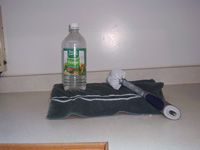 Once a week, sanitize your wooden cutting board with a solution of one part white vinegar to five parts water. Boil water, let it cool, and add the vinegar. Then, over a sink, flood the surface of your cutting board and let it sit. For even better results, choose a clean towel the approximate size of the cutting board (preferably one that hasn’t been treated with fabric softener), place this on top of the board and drench the towel. Let this sanitizing solution sit until it—or the towel—is completely cool. Then rinse and dry.
Once a week, sanitize your wooden cutting board with a solution of one part white vinegar to five parts water. Boil water, let it cool, and add the vinegar. Then, over a sink, flood the surface of your cutting board and let it sit. For even better results, choose a clean towel the approximate size of the cutting board (preferably one that hasn’t been treated with fabric softener), place this on top of the board and drench the towel. Let this sanitizing solution sit until it—or the towel—is completely cool. Then rinse and dry.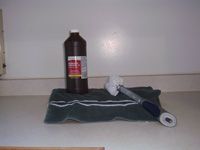 If you are worried vinegar and water isn’t strong enough to kill the germs living on your wooden cutting board, switch to hydrogen peroxide, which is safe for human consumption (some people even use it to brush their teeth). Apply it in the same fashion as the vinegar and water, but don’t dilute it. Over-the-counter hydrogen peroxide has about three percent of the active ingredient, though it is possible to find the six-percent variety, which works even better. (P.S. Don’t be alarmed if your wooden cutting board bubbles; that’s merely the hydrogen peroxide killing germs.)
If you are worried vinegar and water isn’t strong enough to kill the germs living on your wooden cutting board, switch to hydrogen peroxide, which is safe for human consumption (some people even use it to brush their teeth). Apply it in the same fashion as the vinegar and water, but don’t dilute it. Over-the-counter hydrogen peroxide has about three percent of the active ingredient, though it is possible to find the six-percent variety, which works even better. (P.S. Don’t be alarmed if your wooden cutting board bubbles; that’s merely the hydrogen peroxide killing germs.)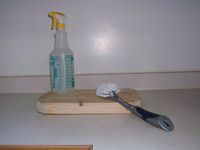 For day-to-day cleaning of your wooden cutting board, keep a bottle of your favorite sanitizer (vinegar/water or hydrogen peroxide) near the sink and use it faithfully every evening to minimize the need for exhaustive monthly maintenance. Don’t forget to rinse and dry.
For day-to-day cleaning of your wooden cutting board, keep a bottle of your favorite sanitizer (vinegar/water or hydrogen peroxide) near the sink and use it faithfully every evening to minimize the need for exhaustive monthly maintenance. Don’t forget to rinse and dry.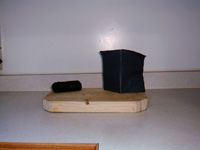 Once a month, resurface your wooden cutting board to prevent bacteria buildup. The object of this step is to restore the tight grain of the wood, which gets damaged by sharp knives, harsh scrubbers (a Chore Boy, for example), and the careless handling of people in a hurry to get food on the table before those dining eat the dishes instead. For this step, use either very fine sandpaper (220‒240 grit black, or wet/dry), or very fine steel wool (00). Rub the surface of the board until it feels soft and scratch-free. The sanding not only removes blemishes from the wood, but also removes minuscule pockets that may harbor food and bacteria. This should take you about 30 minutes. When done, wipe the board clean with a tack cloth and seal it with mineral oil, a non-biodegradable substance that won’t “feed” bacteria. Mineral oil, in small amounts, is also safe for consumption. In fact, some people use it as a safe, natural laxative.
Once a month, resurface your wooden cutting board to prevent bacteria buildup. The object of this step is to restore the tight grain of the wood, which gets damaged by sharp knives, harsh scrubbers (a Chore Boy, for example), and the careless handling of people in a hurry to get food on the table before those dining eat the dishes instead. For this step, use either very fine sandpaper (220‒240 grit black, or wet/dry), or very fine steel wool (00). Rub the surface of the board until it feels soft and scratch-free. The sanding not only removes blemishes from the wood, but also removes minuscule pockets that may harbor food and bacteria. This should take you about 30 minutes. When done, wipe the board clean with a tack cloth and seal it with mineral oil, a non-biodegradable substance that won’t “feed” bacteria. Mineral oil, in small amounts, is also safe for consumption. In fact, some people use it as a safe, natural laxative.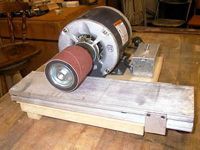 If once-a-week sterilizing and once-a-month refinishing isn’t enough to rescue your cracked, warped, pocked chopping board, you have two options. The first depends on the board’s original thickness: if it’s at least an inch thick, you can enlist a cabinet maker to put the board under a bench-top drum (or thickness) sander. This is the wooden cutting board equivalent of a face lift, removing up to an eighth of an inch of surface wood (a job you probably couldn’t do at home without taking the equivalent amount of skin off your knuckles). The second requires you to throw your cutting board away and buy a new one. Tragic as this is, it’s still better than ripping out an entire section of butcher block countertops. But don’t expect to find a replacement wooden cutting board on your foray to Target, Walmart, or Kohl’s, where the “in thing” is only slightly thicker than a placemat, and made of plastic or glass. You can, however, let your fingers do the walking—via your keyboard and the Internet—and find some fairly decent, affordable wooden cutting boards. Some are even made of resource-friendly bamboo. Thank you, China!
If once-a-week sterilizing and once-a-month refinishing isn’t enough to rescue your cracked, warped, pocked chopping board, you have two options. The first depends on the board’s original thickness: if it’s at least an inch thick, you can enlist a cabinet maker to put the board under a bench-top drum (or thickness) sander. This is the wooden cutting board equivalent of a face lift, removing up to an eighth of an inch of surface wood (a job you probably couldn’t do at home without taking the equivalent amount of skin off your knuckles). The second requires you to throw your cutting board away and buy a new one. Tragic as this is, it’s still better than ripping out an entire section of butcher block countertops. But don’t expect to find a replacement wooden cutting board on your foray to Target, Walmart, or Kohl’s, where the “in thing” is only slightly thicker than a placemat, and made of plastic or glass. You can, however, let your fingers do the walking—via your keyboard and the Internet—and find some fairly decent, affordable wooden cutting boards. Some are even made of resource-friendly bamboo. Thank you, China!
Tips for Maintaining Your Wooden Cutting Board
- If possible, have two wood cutting boards in the kitchen at all times: one for cutting meat, poultry and cheese, and the other for chopping salad greens or nuts and slicing bread. Mark them accordingly.
- Don’t put your cutting board in the dishwasher. While the intensely hot water is excellent for sanitizing dishes, silverware, pots and pans, it is very hard on wood surfaces. Don’t put wooden salad bowls or spoons in the dishwasher either; clean them the same way you’d clean your wooden/bamboo cutting board.
- Don’t allow moisture to sit on the surface of your wooden cutting board. If you cut up a cucumber, wipe the board. Ditto if you slice tomatoes, or any other high-moisture vegetable. And the goo from cutting up a whole chicken? Well, that’s just disgusting, and the sooner you wipe it up, the sooner you will feel like eating chicken.
- Cut stinky stuff like onions, garlic, leeks and ginger on a granite or glass cutting board. You may be able to get rid of germs on your wooden cutting board, but you will never get rid of the smell, and lemon juice is only a disguise—like using cologne instead of showering.
Green Cleaning All Around Your Kitchen
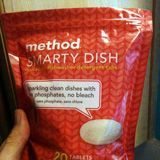 Smarty Dish is a “green” dishwashing machine detergent in tablet form containing mineral cleaning salts; naturally derived anti-spotting agents; starch- and protein-based cleaning enzymes; seaweed-derived dispersing agent; and fragrance oil blend. You can order these in a variety of kinds from Amazon.
Smarty Dish is a “green” dishwashing machine detergent in tablet form containing mineral cleaning salts; naturally derived anti-spotting agents; starch- and protein-based cleaning enzymes; seaweed-derived dispersing agent; and fragrance oil blend. You can order these in a variety of kinds from Amazon.
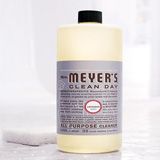 Mrs. Meyer’s Clean Day biodegradable kitchen cleaning products are all biodegradable, don’t contain any nasty chemicals or animal-based ingredients, come in 100% recyclable packaging, and they never test on animals.
Mrs. Meyer’s Clean Day biodegradable kitchen cleaning products are all biodegradable, don’t contain any nasty chemicals or animal-based ingredients, come in 100% recyclable packaging, and they never test on animals.
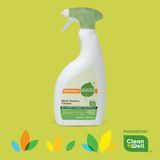 Seventh Generation’s plant-based surface disinfectant kills over 99.99% of household germs. You don’t want to use it on your wooden cutting board, but on hard, nonporous surfaces such as your kitchen counter.
Seventh Generation’s plant-based surface disinfectant kills over 99.99% of household germs. You don’t want to use it on your wooden cutting board, but on hard, nonporous surfaces such as your kitchen counter.